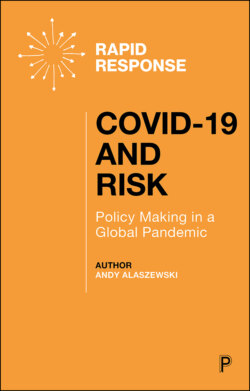Читать книгу COVID-19 and Risk - Alaszewski Andy - Страница 23
На сайте Литреса книга снята с продажи.
A policy shift in mid-March
ОглавлениеOn Monday 16 March 2020, at a press conference, the Prime Minister, Boris Johnson, announced a major change in government policy, moving from business as usual to what he referred to ‘this very draconian measure’ (Rev, 2020), a lockdown of all non-essential social and economic activities on 23 March. He stated that as the epidemic was approaching its fast-growth phase, the whole population was at risk and ‘now is the time for everyone to stop non-essential contact with others and to stop all unnecessary travel’ (Rev, 2020). This speech marked a clear shift from seeking to mitigate the effects of the virus by protecting those most at risk to controlling its spread. At the same time, the government abandoned its efforts to monitor the spread of the virus, abandoning community tracking and tracing contacts.
There were two main reasons for this shift: hostile scientific opinion and predictions of high death rates. Patrick Vallance’s public endorsement of herd immunity elicited a strong response from the scientific community. 500 UK academics and 40 international academics wrote an open letter to the government calling for the introduction of social distancing measures (UK Scientists, 2020).
On 16 March 2020, researchers at Imperial College published a report predicting the outcome of different decisions. They predicted that if the government took no action there would probably be 510,000 additional deaths between April and August 2020 (Ferguson et al, 2020, p. 6). If the government took measures to mitigate the effects of the spread of the virus by protecting the most vulnerable, there would be 250,000 deaths (Ferguson et al, 2020, p. 16). But if the government locked down it could substantially reduce overall mortality. Policy makers did not want to be responsible for the death of 250,000 people so accepted the necessity of a lockdown. As a participant in the decision-making process noted: ‘There was a collision between the science and reality’ (Shipman and Wheeler, 2020).
